We’re stepping back in time, way back, to a period in Earth’s history when fungi ruled the land. Yes, you heard that right—there was a time when the tallest organisms on Earth weren’t trees but giant fungi towering like skyscrapers over a barren, mossy landscape.
Picture this: It’s about 400 million years ago. The air is heavy with moisture, the land is rocky and bare, and there’s hardly a tree or a flower in sight. The world is dominated by mosses, liverworts, and…something massive. Looming above it all are colossal fungal structures called Prototaxites, reaching heights of up to 26 feet. That’s taller than most garden trees today!”
Prototaxites – The Ancient Giant
So, what exactly were these giant fungi? For a long time, scientists didn’t know. Prototaxites were first discovered in fossil form over a century ago, and people thought they might be trees, algae, or even lichens. But as researchers studied their structure under the microscope, they found something remarkable—Prototaxites were made of tightly packed hyphae. If you’ve ever looked closely at a mushroom stem, you’ve seen hyphae in action. These thread-like structures are a hallmark of fungi.
Imagine being alive back then, wandering a landscape dominated by towering fungal pillars. At up to 8 meters tall and over a meter wide, Prototaxites would’ve been impossible to miss. In a world without trees, they were the skyscrapers of their time.
The Role of Fungi in Early Ecosystems
Now, fungi like Prototaxites weren’t just towering giants—they were also ecological engineers. Back then, vascular plants—the kind of plants that have roots, stems, and leaves—were just starting to evolve. Most of the land was covered in mossy mats and simple organisms. Prototaxites played a critical role in this primitive ecosystem by breaking down organic material and helping to form soil. Without them, the land may never have become hospitable enough for plants to thrive.
But why were they so tall? Well, one theory is that their height helped them disperse spores over long distances. Just like modern fungi release spores into the air, Prototaxites might have used their towering height to colonize vast areas.
The Fall of the Fungi Giants
Of course, nothing lasts forever—not even the reign of the mighty Prototaxites. As the Devonian period progressed, vascular plants like ferns and early trees began to dominate. With their roots, they stabilized the soil and grew larger, eventually shading out the fungi. By about 350 million years ago, Prototaxites had disappeared, replaced by lush forests that marked the next great chapter in Earth’s history.
What This Means for Gardeners
So, what can we gardeners learn from this fungal golden age? Well, fungi are still a cornerstone of every healthy ecosystem—even in your garden. They break down organic material, recycle nutrients, and form symbiotic relationships with plant roots. Mycorrhizal fungi, for example, help plants absorb water and nutrients, making them essential for healthy growth. Without fungi, there’d be no rich soil and no thriving plants.
If you’re looking to boost the health of your garden, consider adding mycorrhizal inoculants when planting. Or, if you’re composting, remember that fungi are doing much of the heavy lifting in breaking down tough organic material. You can even let mushrooms grow freely in your garden—they’re a sign that your soil is alive and thriving.
Closing
The story of Prototaxites reminds us just how much we owe to fungi. They prepared the Earth for plants and ultimately for us. So, the next time you spot a mushroom in your garden, think of its ancient ancestors—towering giants that once ruled the Earth.
Thanks for joining me on this journey into the past. Next time, we’ll be talking about the rise of the first trees and how they changed the world forever. Until then, keep digging, keep planting, and remember—the more you know about the natural world, the better gardener you’ll be. See you next time!




